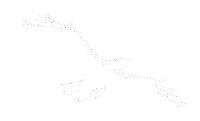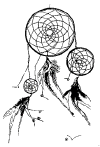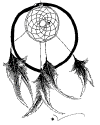CHAPTER XX.
CLOSING OF THE WAR BETWEEN THE OJIBWAYS AND ODUGAMIES.
The Odugamies, after partially regaining their former
numbers, make their last tribal effort against the Ojibways--Battle of St.
Croix Falls--Tradition of this event, as told by the Ojibways--Waub-o-jeeg
collects a war party at La Pointe--He proceeds at the head of 300 men into
the Dakota country-Failure of the Sandy Lake warriors to keep their
appointment--Landing of the Ojibways at the head of the St. Croix
Falls--They discover the allied Odugamies and Dakotas landing at the foot of
the Falls--Preparations for battle--Ojibways and Odugamies engage--Odugamies
are beaten, and Dakotas rally to their rescue--Ojibways are forced to
retreat, but are reinforced by 60 warriors from Sandy Lake--Disastrous
flight and loss of their enemies--Waub-o-jeeg loses his brother, and is
himself wounded--Remnants of the Odugamies ask to be incorporated with the
Osaugees--Their prayer is granted--Waub-o-jeeg--A sketch of his life.
The Odugamies (Foxes), who had been forced by the Ojibways
during the French domination to retire from the Wisconsin and Fox Rivers to
the Mississippi, had, under the guardianship of the Osaugees, partially
regained their former strength and numbers; and, still smarting from the
repeated and powerful blows which their fathers had received at the hands of
the Ojibways about eighty years ago, they made their last grand tribal
effort to revenge their wrongs and regain a portion of their former country.
They ascended in war canoes the current of the broad
Mississippi, and prevailing on their former allies, the Dakotas, to join
them, together they proceeded up the St. Croix. While crossing their canoes
over the portage at the Falls of this river, they encountered a war party of
Ojibways, and here, among the rocks and boulders of the St. Croix, the
Odugamies fought their last tribal battle.
The account which the old men of the Ojibways give of this
important event is briefly as follows: Waub-o-jeeg (White Fisher), the son
of Ma-mong-e-se-da, had succeeded on his father's death, to the war
chieftainship of the Lake Superior Ojibways. He was a brave and a wise man,
who had already become famous for the success of every party which he
joined, or led, against the hereditary enemies of his tribe. On this
occasion, he sent his club of war, tobacco, and wampum, to all the scattered
bands of the Ojibways, to collect a war party to proceed against the Dakota
villages on the St. Croix and Mississippi, who had lately very much annoyed
their hunting camps in this district. Warriors from the Falls of St. Marie,
Grand Island, Kuk-kewa-on-an-ing (L'Ance), the Wisconsin and Grand Portage,
obeyed his call, and at the head of three hundred men Waub-o-jeeg started
from La Pointe, Shaug-a-waum-ik-ong.
In their light birch-bark canoes, they ascended the left
branch of the Mush-kee-se-be or "Bad River," to its head, and made a portage
of ten miles in length to Long Lake, beautiful sheet of clear water, which
lies on the dividing summit between the Mississippi and Lake Superior.
Making three more short portages from lake to lake, they at last embarked on
the Num-a-kaug-un branch of the St. Croix, and having now entered the
dangerous country of their enemies, the wise leader proceeded slowly,
keeping scouts continually ahead, to prevent surprise from an ambuscade. It
took him six days to descend to the mouth of Snake River, where he expected
to meet a party of warriors from the Sandy Lake and Mille Lac villages. He
had sent them his war club and tobacco, with word that "at a given time he
would be on the waters of the St. Croix searching for their enemies," and
they had sent tobacco and word in return, that "sixty of their warriors
would join him on a certain day at the meeting of the waters of the Snake
and St. Croix Rivers." On arriving at the spot designated, Waub-o-jeeg
discovered no signs of the promised party, but still confident in his
numbers, he continued on his course down stream.
The Ojibways arrived at the head of the St. Croix Falls (a
distance of two hundred and fifty miles from their starting point), early in
the morning, and while preparing to take their bark canoes over the rugged
portage, or carrying place, the scouts who had been sent in advance,
returned with the information that a very large war party of Odugamies and
Dakotas were landing at the foot of the falls, apparently with the intention
of crossing over their wooden canoes. Now, commenced the hurry and
excitement of approaching battle. The "novices," or those of the party who
were on their first warpath, were forcibly driven back into the water by the
elder warriors, there to wash off the black paint which denoted their
condition of initiates into the mysteries of war. This customary procedure
on the eve of an attack or battle, being performed, the warriors grasped
their medicine bags, and hurriedly adorned their faces and naked bodies with
war paint, those that earned them planted the eagle plumes on their
head-dress, which denoted enemies they had slain or scalps taken, and the
pe-na-se-wi-am, holding the charms of supposed invulnerability, were
attached to different portions of their head-dress, armlets, or belts.
During this busy scene of preparation for the coming
contest, the war leader called on the Great Spirit with a loud voice for
protection to his followers and success against their enemies. Then
addressing his fellows, his clear voice rang among the rocks and mingled
with the noise of the waterfall, as he urged them to fight like men, be
strong of heart, at the same time advising them to be careful of their
lives, that their relatives might not weep in mourning for their loss.
Having finished these customary preparations, the Ojibways, grasping their
arms, proceeded to find their enemies. The scouts of their opponents had
already discovered them, and the two parties, as if by mutual agreement, met
in the middle of the portage. The battle, which ensued, was the most
chivalric which is told of in their traditions. The Odugamies, after seeing
the comparatively small number of the Ojibways, and over confident in the
prowess of their own more numerous warriors, are said to have requested
their allies, the Dakotas, to stand quietly by, to witness how quickly they
would gather the scalps of the Ojibways.
This request was granted, and the Dakotas retired to an
adjacent eminence, and calmly filling their pipes, they viewed the conflict
as though perfectly unconcerned. The fight between the warriors of the two
contending tribes is said to have been fiercely contested, and embellished
with many daring acts of personal valor. The voices of the war chiefs
resounded above the rattle of musketry and yells of their warriors, as they
urged them to stand their ground, and not turn their backs in flight. In
fact the nature of the ground on which they fought was such, that retreat
was almost impracticable for either party. It was a mere rugged neck of
rock, cut up into deep ravines, through which the deep and rapid current of
the river forces a narrow passage, and at either end of the portage a sudden
embarkation into their frail canoes could not safely be effected in face of
an enemy. There is a wood around the portage on the landside, inclosing the
neck of rock over which it leads, and only through this could the beaten
party safely retreat. Waub-o-jeeg, early in the fight secured this important
point, by sending thither a number of his warriors.
About midday, after fighting with great desperation, the
Odugamies began to give ground, and they were at last forced to turn and
flee in confusion. They would probably have been killed and driven into the
river to a man, had not their allies, the Dakotas, arose from their seats at
this juncture, and yelling their war-whoop, rushed to the rescue of their
discomfited allies. The Ojibways resisted their new enemies manfully, and it
was not till their ammunition had entirely failed, that they in turn showed
their backs in flight. But few would tell the sad tale of defeat and the
death of brave men, had not the party of sixty warriors from Sandy Lake, who
were to have joined them at the mouth of Snake River, arrived at this
opportune moment, and landed at the head of the portage. Eager for the
fight, and fresh on the field, the band rushed forward and withstood the
onset of the Odugamies and Dakotas, till their friends could rally again to
the battle.
After a short but severe contest, the warriors of the two
allied tribes were forced to flee, and the slaughter in their ranks is said
to have been great. Many were driven over the rocks into the boiling floods
below, there to find a watery grave. Others, in attempting to jump into
their narrow wooden canoes, were capsized into the rapids. Every crevice in
the cliffs where the battle had been fought, contained a dead or wounded
enemy. The Ojibways suffered a severe loss in the death of a large number of
their bravest warriors. The brother of Waub-o-jeeg was numbered among the
dead, and the war-chief himself carried on his person the marks of the
sanguinary fight, in a wound on his breast. But a few of the Odugamies
escaped, and from this time they forever gave up the contest with the
victorious Ojibways. They retired to the south, far away from the reach of
the war-club, which had so often made them to weep, and now so nearly
exterminated their warriors.
The old Ojibway chief, "Great Buffalo," of La Pointe, says
that the fire of the Odugamies was, by this last stroke, nearly
extinguished, and they were reduced to fifteen lodges. A second time they
went weeping to the village of the Osaugees, who had intermarried with them
to a considerable extent, and begged to be incorporated in their tribe, and
to live under their powerful protection. They offered to be their cutters of
wood and carriers of water, and filled with compassion at their broken
numbers and tears of sorrow, the Osaugees, who are a family of the Algic
stock, at last, for the first time, formally received them into their tribe,
and it is only from this period that the fire of these two tribes (whose
names are so linked together in modern history), can be truly said as having
become one and undivided.
The old men of the Ojibways assert that the Odugamies
speak a distant language,1 and do not really belong to the Algonquin council
fires, and it is only since their close intercourse with the Osaugees that
the Algonquin language has become in use among them. I am aware that this
assertion is directly contrary to the results of Mr. Schoolcraft's
researches, which places the Odugamies as one of the most prominent tribes
of the Algics. Never having had the advantage of comparing the peculiar
dialect of this tribe with the Ojibway, I am consequently not prepared to
deliver a direct opinion. Their warfare with the Odugamies has been of such
long standing and so sanguinary, that the Ojibways may naturally consider
them as much a distinct race from themselves, as the Dakotas or Winnebagoes,
the last of whom, in time of peace, they are accustomed to denominate as
"younger brothers," which circumstance, however, should not mislead us into
the belief that they consider them as being really a kindred tribe in any
closer degree than their being respective families of the red race in
general. A French memoir on the Indians between Lake Erie and the
Mississippi River, prepared in 1718, and which appears as Paris, Doc. vii.
in N. Y. Col. Doc. vol. ix., contains this statement: "The Foxes are
eighteen leagues from the Sacs, they number five hundred men, abound in
women and children, are as industrious as they can be, and have a different
language from the Outaouaes. An Outaouae interpreter would be of no use with
the Foxes."--E. D. N.
As I shall not probably again have occasion to mention, in
the further course of my narrative, the name of the distinguished war-chief
who led the Ojibways in the battle of St. Croix Falls, which so effectually
put a final stop to their old war with the Odugamies, I will here present to
the reader a brief account of his short but brilliant career.
Mr. Schoolcraft, in one of his valuable works on the red
race, has given an elaborate notice of the life of this noted chieftain, and
as he doubtless obtained his information from his direct descendants, nearly
thirty years since,when he acted in the official capacity of United States
agent among the Ojibways, and when the acts of Waub-o-jeeg were still
comparatively new in the traditions of his tribe, the account which he has
given can be implicitly relied on, and very little, if anything, can be
added to it.
We glean from this that Waub-o-jeeg was born about the
year 1747. He early gave indications of courage, and, Mr. Schoolcraft
relates this anecdote, that on the occasion which we have mentioned in a
previous chapter, when his father, Ma-mong-e-se-da, turned a sudden attack
of the Dakotas on his camp into a peace visit, by calling out for his
half-brother, the Dakota chief, Wabasha--Waub-o-jeeg, then a mere boy,
posted himself with a war-club close to the door of his father's lodge, and
as his tall Dakota uncle entered, he gave him a blow. Wabasha, pleased with
the little brave, took him in his arms, caressed him, and predicted that he
would become a brave man, and prove an inveterate enemy of the Dakotas. Mr.
Schoolcraft continues his biographical notice of Waub-o-jeeg as follows:--
"The border warfare in which the father of the infant
warrior was constantly engaged, early initiated him in the arts and
ceremonies pertaining to war. With the eager interest and love of novelty
of the young, he listened to their war songs and war stories, and longed
for the time when he would be old enough to join these parties, and also
make himself a name among warriors. While quite a youth, he volunteered to
go out with a party, and soon gave convincing proof of his courage. He
also early learned the arts of hunting the deer, the bear, the moose, and
all the smaller animals common to the country; and in these pursuits he
took the ordinary lessons of Indian young men in abstinence, suffering,
danger, and endurance of fatigue. In this manner his nerves were knit and
formed for activity, and his mind stored with those lessons of caution,
which are the result of local experience in the forest. He possessed a
tall and commanding person, with a full, black, piercing eye, and the
usual features of his countrymen. He had a clear and full-toned voice, and
spoke his native language with grace and fluency. To these attractions he
united an early reputation for bravery and skill in the chase, and at the
age of twenty-two, he was already a war leader."
conclude chapter
20
1
- 2
- 3
- 4
- 5
- 6
- 7
- 8
- 9
- 10
11
- 12
- 13
- 14
- 15
- 16
- 17
- 18
- 19
- 20
21
- 22
- 23
- 24
- 25 - 26 - 27 - 28 - 29 - 30
White Eagle Soaring: Dream Dancer of the 7th Fire







 Get
a course to promote your business online, explode your sales
Get
a course to promote your business online, explode your sales Get
software to promote your business online in less time
Get
software to promote your business online in less time Get
software to streamline your business and run it hands free.
Get
software to streamline your business and run it hands free.